City and Islington College - Final Accounts Project - L3 Business
VerifiedAdded on 2022/12/27
|14
|2438
|33
Project
AI Summary
This project presents a comprehensive solution to a final accounts assignment, addressing key aspects of financial accounting. The project includes the completion of fill-in-the-gaps exercises, preparation of balance sheets and profit and loss accounts, and detailed comments on the results. It covers topics such as depreciation of fixed assets, provision for depreciation, accruals, and prepayments, with explanations and examples. The assignment involves calculations of profit or loss on disposal, comparisons of straight-line and reducing balance depreciation methods, and analysis of the effects of accruals and prepayments on net profit. The student provides trading, profit and loss accounts and balance sheets for different periods, followed by detailed commentary on the financial performance and position of the businesses. The project also includes the importance of depreciation and its application to final accounts and why provision for depreciation is needed. References from academic journals and books are also included to support the arguments.

Final Accounts
1
1
Paraphrase This Document
Need a fresh take? Get an instant paraphrase of this document with our AI Paraphraser
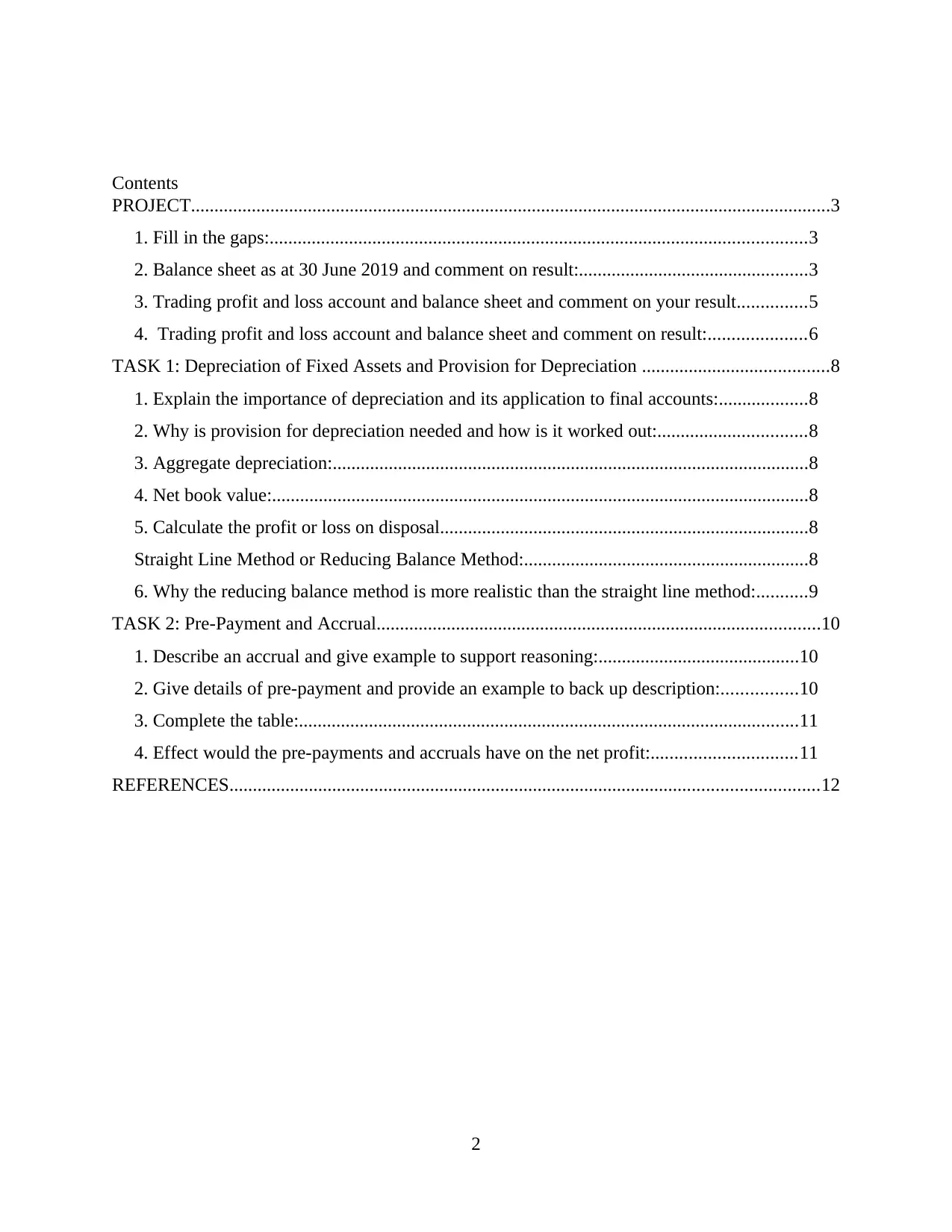
Contents
PROJECT.........................................................................................................................................3
1. Fill in the gaps:...................................................................................................................3
2. Balance sheet as at 30 June 2019 and comment on result:.................................................3
3. Trading profit and loss account and balance sheet and comment on your result...............5
4. Trading profit and loss account and balance sheet and comment on result:.....................6
TASK 1: Depreciation of Fixed Assets and Provision for Depreciation ........................................8
1. Explain the importance of depreciation and its application to final accounts:...................8
2. Why is provision for depreciation needed and how is it worked out:................................8
3. Aggregate depreciation:......................................................................................................8
4. Net book value:...................................................................................................................8
5. Calculate the profit or loss on disposal...............................................................................8
Straight Line Method or Reducing Balance Method:.............................................................8
6. Why the reducing balance method is more realistic than the straight line method:...........9
TASK 2: Pre-Payment and Accrual...............................................................................................10
1. Describe an accrual and give example to support reasoning:...........................................10
2. Give details of pre-payment and provide an example to back up description:................10
3. Complete the table:...........................................................................................................11
4. Effect would the pre-payments and accruals have on the net profit:...............................11
REFERENCES..............................................................................................................................12
2
PROJECT.........................................................................................................................................3
1. Fill in the gaps:...................................................................................................................3
2. Balance sheet as at 30 June 2019 and comment on result:.................................................3
3. Trading profit and loss account and balance sheet and comment on your result...............5
4. Trading profit and loss account and balance sheet and comment on result:.....................6
TASK 1: Depreciation of Fixed Assets and Provision for Depreciation ........................................8
1. Explain the importance of depreciation and its application to final accounts:...................8
2. Why is provision for depreciation needed and how is it worked out:................................8
3. Aggregate depreciation:......................................................................................................8
4. Net book value:...................................................................................................................8
5. Calculate the profit or loss on disposal...............................................................................8
Straight Line Method or Reducing Balance Method:.............................................................8
6. Why the reducing balance method is more realistic than the straight line method:...........9
TASK 2: Pre-Payment and Accrual...............................................................................................10
1. Describe an accrual and give example to support reasoning:...........................................10
2. Give details of pre-payment and provide an example to back up description:................10
3. Complete the table:...........................................................................................................11
4. Effect would the pre-payments and accruals have on the net profit:...............................11
REFERENCES..............................................................................................................................12
2
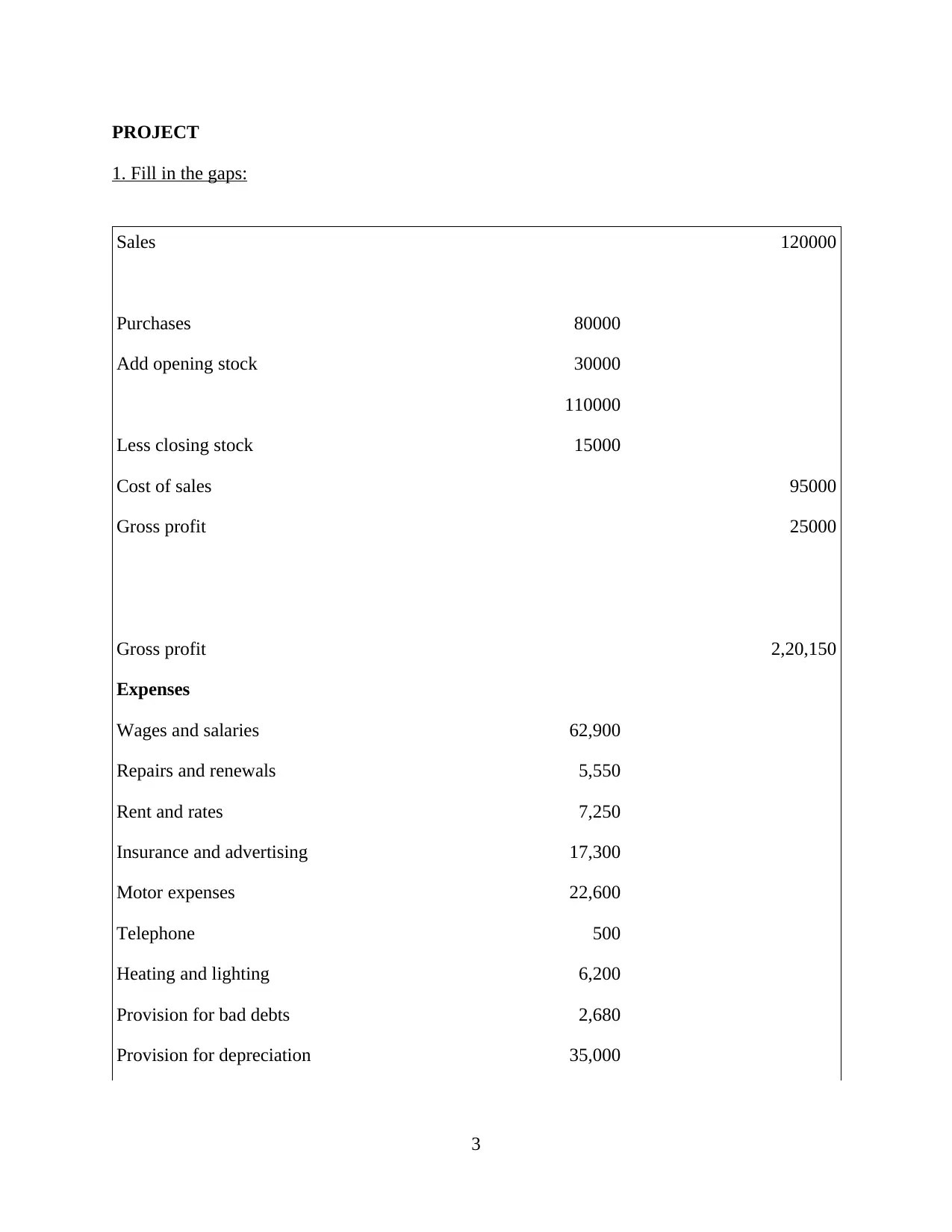
PROJECT
1. Fill in the gaps:
Sales 120000
Purchases 80000
Add opening stock 30000
110000
Less closing stock 15000
Cost of sales 95000
Gross profit 25000
Gross profit 2,20,150
Expenses
Wages and salaries 62,900
Repairs and renewals 5,550
Rent and rates 7,250
Insurance and advertising 17,300
Motor expenses 22,600
Telephone 500
Heating and lighting 6,200
Provision for bad debts 2,680
Provision for depreciation 35,000
3
1. Fill in the gaps:
Sales 120000
Purchases 80000
Add opening stock 30000
110000
Less closing stock 15000
Cost of sales 95000
Gross profit 25000
Gross profit 2,20,150
Expenses
Wages and salaries 62,900
Repairs and renewals 5,550
Rent and rates 7,250
Insurance and advertising 17,300
Motor expenses 22,600
Telephone 500
Heating and lighting 6,200
Provision for bad debts 2,680
Provision for depreciation 35,000
3
⊘ This is a preview!⊘
Do you want full access?
Subscribe today to unlock all pages.

Trusted by 1+ million students worldwide
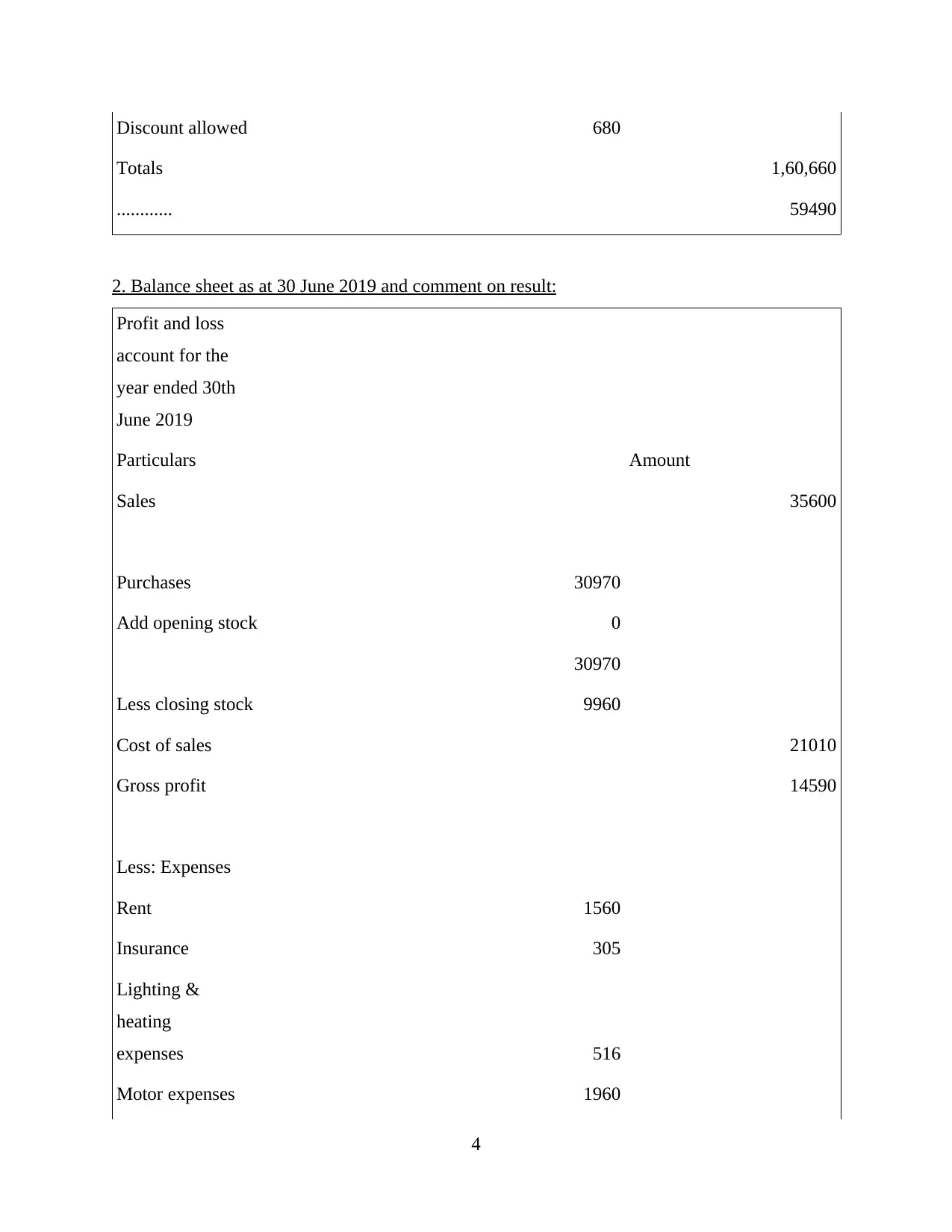
Discount allowed 680
Totals 1,60,660
............ 59490
2. Balance sheet as at 30 June 2019 and comment on result:
Profit and loss
account for the
year ended 30th
June 2019
Particulars Amount
Sales 35600
Purchases 30970
Add opening stock 0
30970
Less closing stock 9960
Cost of sales 21010
Gross profit 14590
Less: Expenses
Rent 1560
Insurance 305
Lighting &
heating
expenses 516
Motor expenses 1960
4
Totals 1,60,660
............ 59490
2. Balance sheet as at 30 June 2019 and comment on result:
Profit and loss
account for the
year ended 30th
June 2019
Particulars Amount
Sales 35600
Purchases 30970
Add opening stock 0
30970
Less closing stock 9960
Cost of sales 21010
Gross profit 14590
Less: Expenses
Rent 1560
Insurance 305
Lighting &
heating
expenses 516
Motor expenses 1960
4
Paraphrase This Document
Need a fresh take? Get an instant paraphrase of this document with our AI Paraphraser
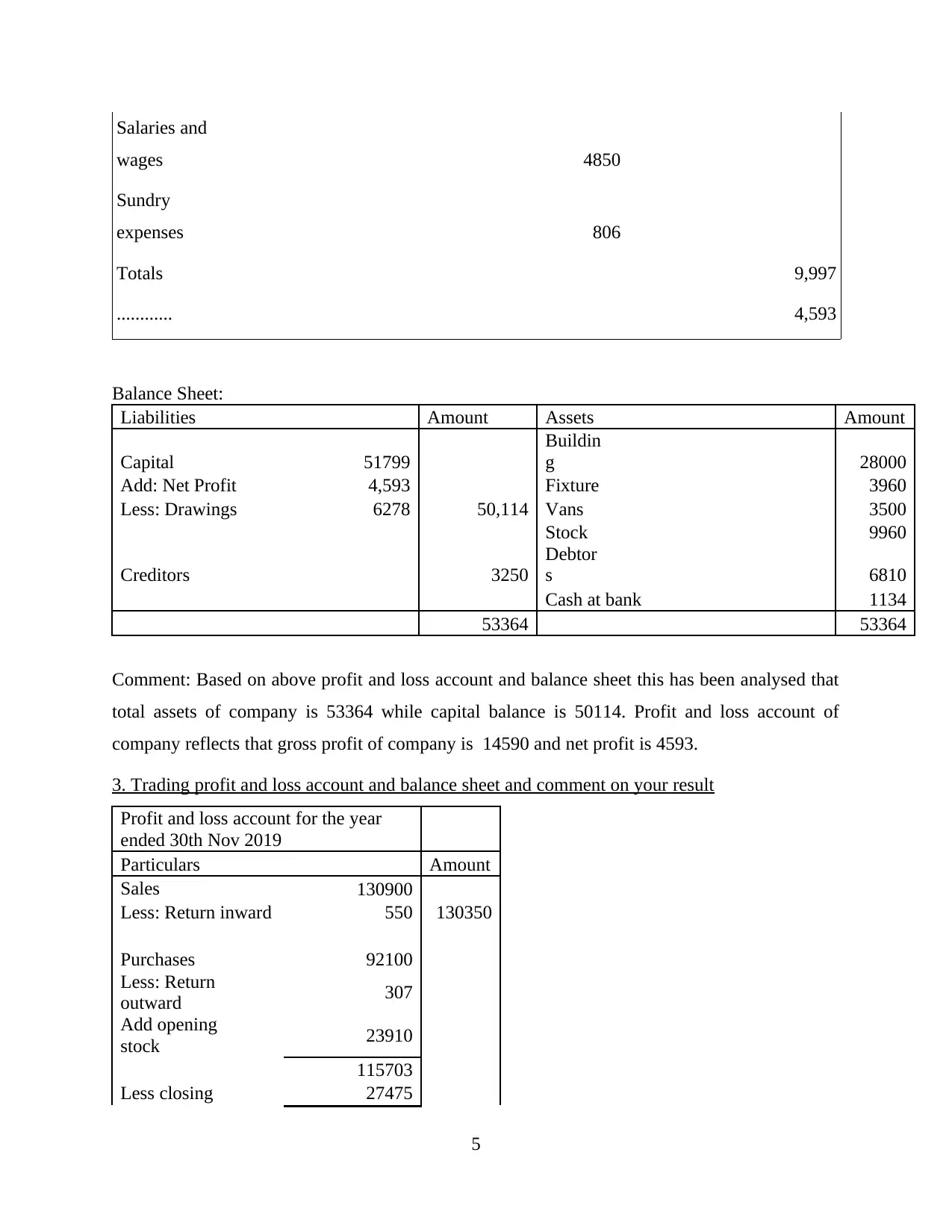
Salaries and
wages 4850
Sundry
expenses 806
Totals 9,997
............ 4,593
Balance Sheet:
Liabilities Amount Assets Amount
Capital 51799
Buildin
g 28000
Add: Net Profit 4,593 Fixture 3960
Less: Drawings 6278 50,114 Vans 3500
Stock 9960
Creditors 3250
Debtor
s 6810
Cash at bank 1134
53364 53364
Comment: Based on above profit and loss account and balance sheet this has been analysed that
total assets of company is 53364 while capital balance is 50114. Profit and loss account of
company reflects that gross profit of company is 14590 and net profit is 4593.
3. Trading profit and loss account and balance sheet and comment on your result
Profit and loss account for the year
ended 30th Nov 2019
Particulars Amount
Sales 130900
Less: Return inward 550 130350
Purchases 92100
Less: Return
outward 307
Add opening
stock 23910
115703
Less closing 27475
5
wages 4850
Sundry
expenses 806
Totals 9,997
............ 4,593
Balance Sheet:
Liabilities Amount Assets Amount
Capital 51799
Buildin
g 28000
Add: Net Profit 4,593 Fixture 3960
Less: Drawings 6278 50,114 Vans 3500
Stock 9960
Creditors 3250
Debtor
s 6810
Cash at bank 1134
53364 53364
Comment: Based on above profit and loss account and balance sheet this has been analysed that
total assets of company is 53364 while capital balance is 50114. Profit and loss account of
company reflects that gross profit of company is 14590 and net profit is 4593.
3. Trading profit and loss account and balance sheet and comment on your result
Profit and loss account for the year
ended 30th Nov 2019
Particulars Amount
Sales 130900
Less: Return inward 550 130350
Purchases 92100
Less: Return
outward 307
Add opening
stock 23910
115703
Less closing 27475
5
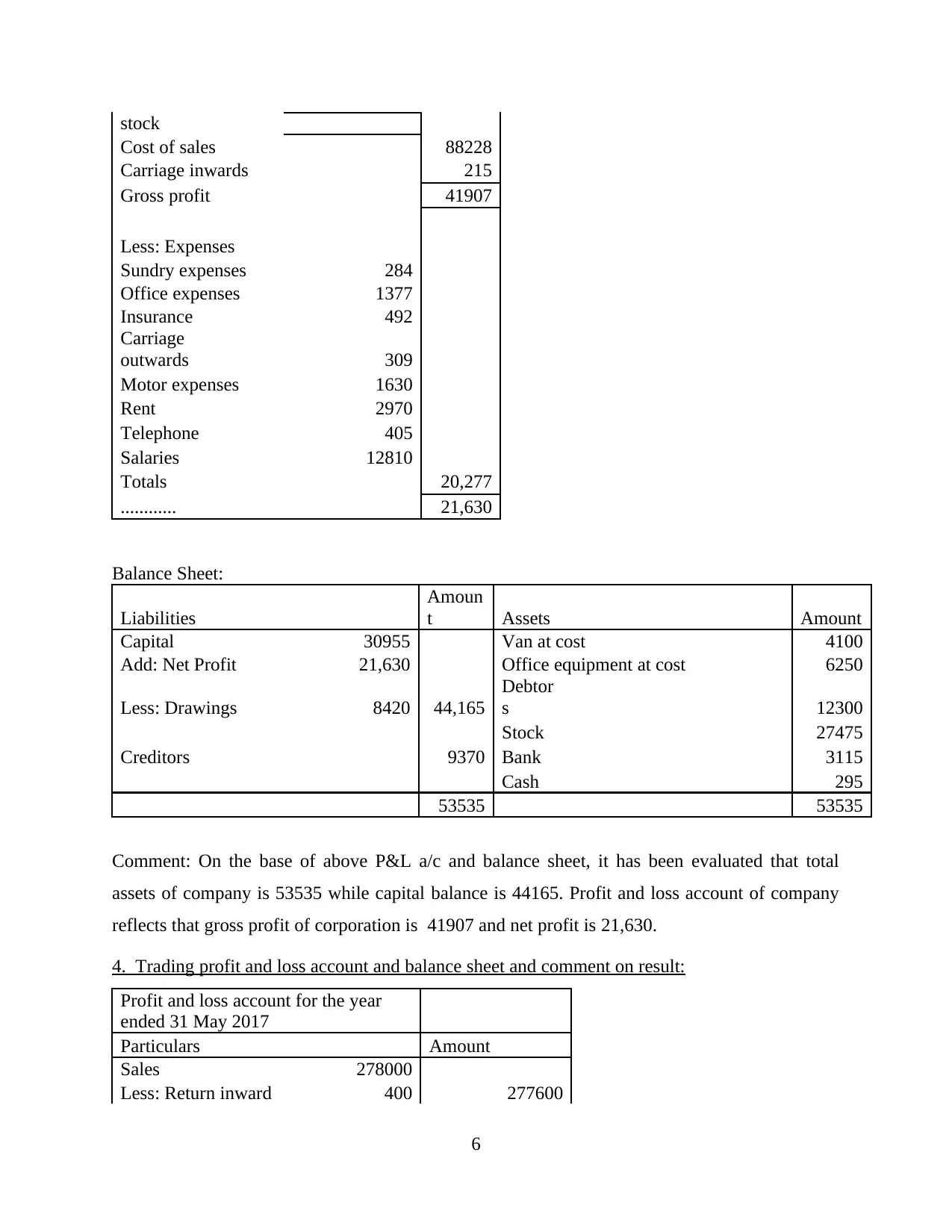
stock
Cost of sales 88228
Carriage inwards 215
Gross profit 41907
Less: Expenses
Sundry expenses 284
Office expenses 1377
Insurance 492
Carriage
outwards 309
Motor expenses 1630
Rent 2970
Telephone 405
Salaries 12810
Totals 20,277
............ 21,630
Balance Sheet:
Liabilities
Amoun
t Assets Amount
Capital 30955 Van at cost 4100
Add: Net Profit 21,630 Office equipment at cost 6250
Less: Drawings 8420 44,165
Debtor
s 12300
Stock 27475
Creditors 9370 Bank 3115
Cash 295
53535 53535
Comment: On the base of above P&L a/c and balance sheet, it has been evaluated that total
assets of company is 53535 while capital balance is 44165. Profit and loss account of company
reflects that gross profit of corporation is 41907 and net profit is 21,630.
4. Trading profit and loss account and balance sheet and comment on result:
Profit and loss account for the year
ended 31 May 2017
Particulars Amount
Sales 278000
Less: Return inward 400 277600
6
Cost of sales 88228
Carriage inwards 215
Gross profit 41907
Less: Expenses
Sundry expenses 284
Office expenses 1377
Insurance 492
Carriage
outwards 309
Motor expenses 1630
Rent 2970
Telephone 405
Salaries 12810
Totals 20,277
............ 21,630
Balance Sheet:
Liabilities
Amoun
t Assets Amount
Capital 30955 Van at cost 4100
Add: Net Profit 21,630 Office equipment at cost 6250
Less: Drawings 8420 44,165
Debtor
s 12300
Stock 27475
Creditors 9370 Bank 3115
Cash 295
53535 53535
Comment: On the base of above P&L a/c and balance sheet, it has been evaluated that total
assets of company is 53535 while capital balance is 44165. Profit and loss account of company
reflects that gross profit of corporation is 41907 and net profit is 21,630.
4. Trading profit and loss account and balance sheet and comment on result:
Profit and loss account for the year
ended 31 May 2017
Particulars Amount
Sales 278000
Less: Return inward 400 277600
6
⊘ This is a preview!⊘
Do you want full access?
Subscribe today to unlock all pages.

Trusted by 1+ million students worldwide
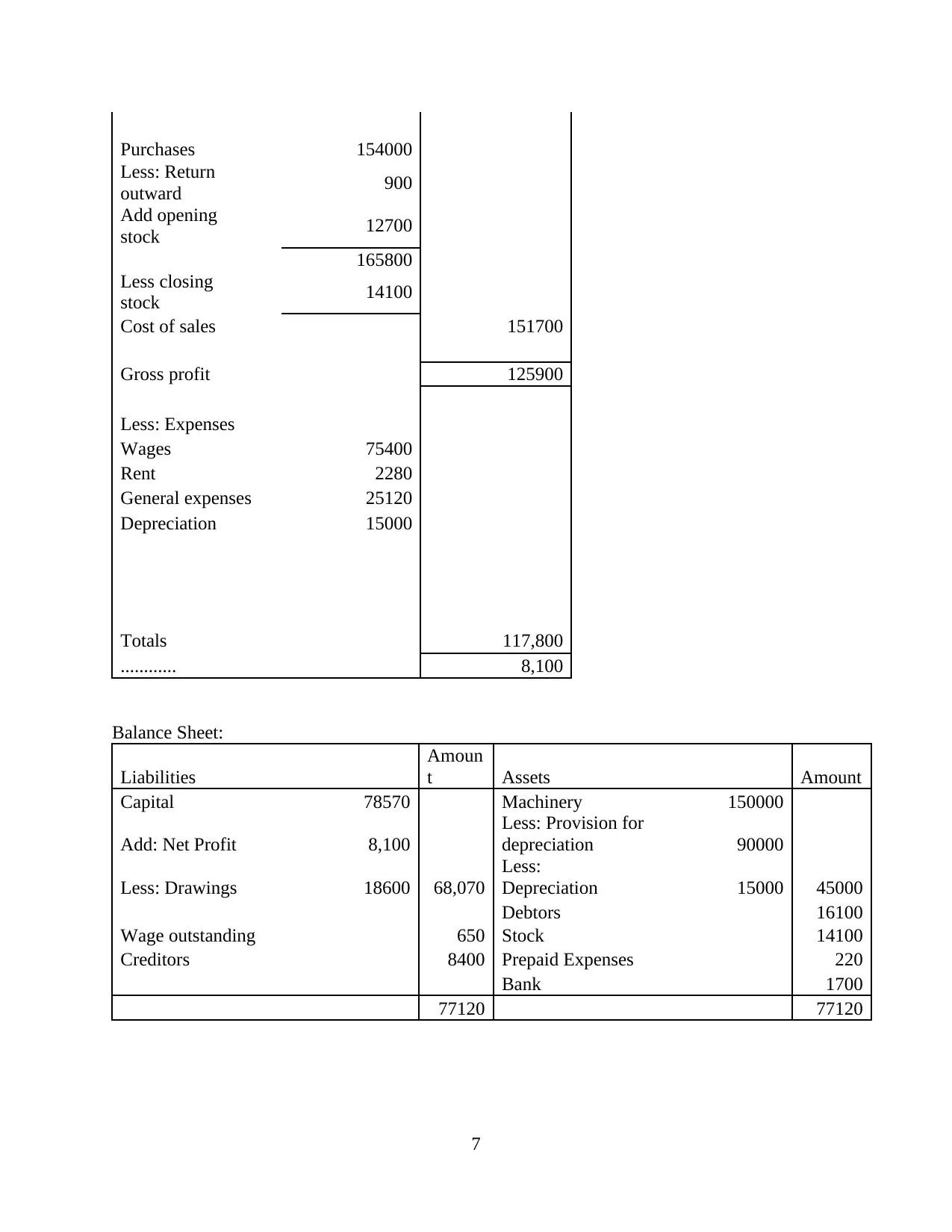
Purchases 154000
Less: Return
outward 900
Add opening
stock 12700
165800
Less closing
stock 14100
Cost of sales 151700
Gross profit 125900
Less: Expenses
Wages 75400
Rent 2280
General expenses 25120
Depreciation 15000
Totals 117,800
............ 8,100
Balance Sheet:
Liabilities
Amoun
t Assets Amount
Capital 78570 Machinery 150000
Add: Net Profit 8,100
Less: Provision for
depreciation 90000
Less: Drawings 18600 68,070
Less:
Depreciation 15000 45000
Debtors 16100
Wage outstanding 650 Stock 14100
Creditors 8400 Prepaid Expenses 220
Bank 1700
77120 77120
7
Less: Return
outward 900
Add opening
stock 12700
165800
Less closing
stock 14100
Cost of sales 151700
Gross profit 125900
Less: Expenses
Wages 75400
Rent 2280
General expenses 25120
Depreciation 15000
Totals 117,800
............ 8,100
Balance Sheet:
Liabilities
Amoun
t Assets Amount
Capital 78570 Machinery 150000
Add: Net Profit 8,100
Less: Provision for
depreciation 90000
Less: Drawings 18600 68,070
Less:
Depreciation 15000 45000
Debtors 16100
Wage outstanding 650 Stock 14100
Creditors 8400 Prepaid Expenses 220
Bank 1700
77120 77120
7
Paraphrase This Document
Need a fresh take? Get an instant paraphrase of this document with our AI Paraphraser
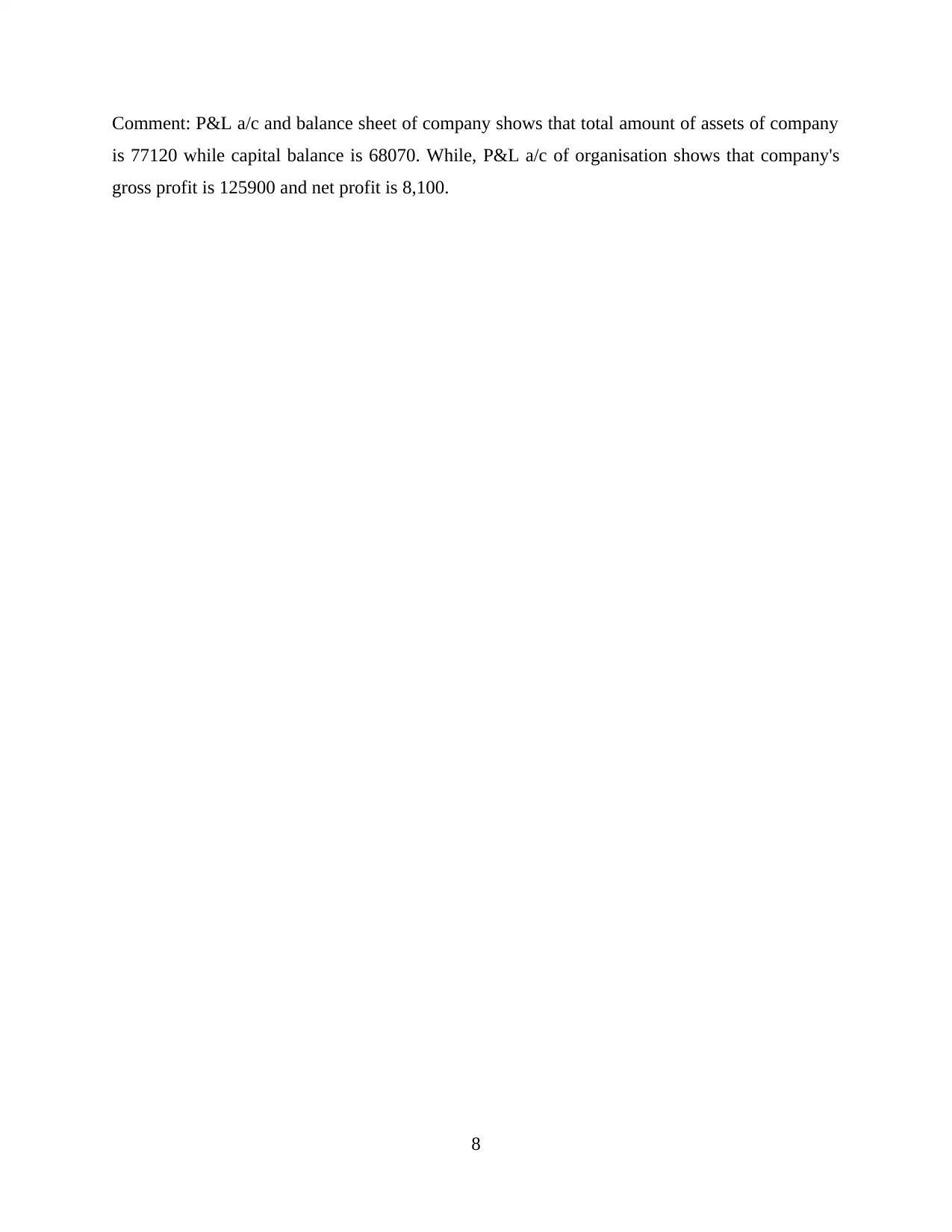
Comment: P&L a/c and balance sheet of company shows that total amount of assets of company
is 77120 while capital balance is 68070. While, P&L a/c of organisation shows that company's
gross profit is 125900 and net profit is 8,100.
8
is 77120 while capital balance is 68070. While, P&L a/c of organisation shows that company's
gross profit is 125900 and net profit is 8,100.
8
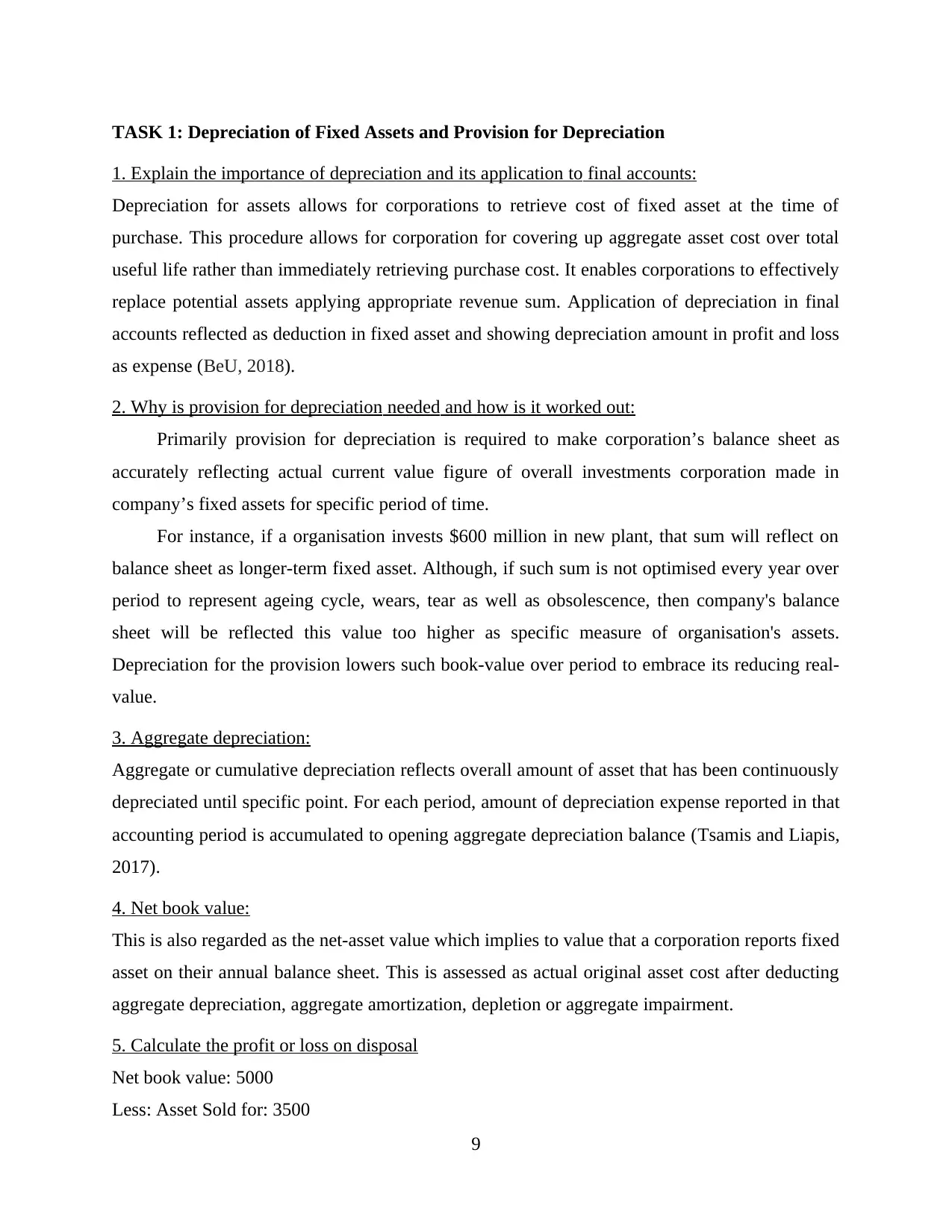
TASK 1: Depreciation of Fixed Assets and Provision for Depreciation
1. Explain the importance of depreciation and its application to final accounts:
Depreciation for assets allows for corporations to retrieve cost of fixed asset at the time of
purchase. This procedure allows for corporation for covering up aggregate asset cost over total
useful life rather than immediately retrieving purchase cost. It enables corporations to effectively
replace potential assets applying appropriate revenue sum. Application of depreciation in final
accounts reflected as deduction in fixed asset and showing depreciation amount in profit and loss
as expense (BeU, 2018).
2. Why is provision for depreciation needed and how is it worked out:
Primarily provision for depreciation is required to make corporation’s balance sheet as
accurately reflecting actual current value figure of overall investments corporation made in
company’s fixed assets for specific period of time.
For instance, if a organisation invests $600 million in new plant, that sum will reflect on
balance sheet as longer-term fixed asset. Although, if such sum is not optimised every year over
period to represent ageing cycle, wears, tear as well as obsolescence, then company's balance
sheet will be reflected this value too higher as specific measure of organisation's assets.
Depreciation for the provision lowers such book-value over period to embrace its reducing real-
value.
3. Aggregate depreciation:
Aggregate or cumulative depreciation reflects overall amount of asset that has been continuously
depreciated until specific point. For each period, amount of depreciation expense reported in that
accounting period is accumulated to opening aggregate depreciation balance (Tsamis and Liapis,
2017).
4. Net book value:
This is also regarded as the net-asset value which implies to value that a corporation reports fixed
asset on their annual balance sheet. This is assessed as actual original asset cost after deducting
aggregate depreciation, aggregate amortization, depletion or aggregate impairment.
5. Calculate the profit or loss on disposal
Net book value: 5000
Less: Asset Sold for: 3500
9
1. Explain the importance of depreciation and its application to final accounts:
Depreciation for assets allows for corporations to retrieve cost of fixed asset at the time of
purchase. This procedure allows for corporation for covering up aggregate asset cost over total
useful life rather than immediately retrieving purchase cost. It enables corporations to effectively
replace potential assets applying appropriate revenue sum. Application of depreciation in final
accounts reflected as deduction in fixed asset and showing depreciation amount in profit and loss
as expense (BeU, 2018).
2. Why is provision for depreciation needed and how is it worked out:
Primarily provision for depreciation is required to make corporation’s balance sheet as
accurately reflecting actual current value figure of overall investments corporation made in
company’s fixed assets for specific period of time.
For instance, if a organisation invests $600 million in new plant, that sum will reflect on
balance sheet as longer-term fixed asset. Although, if such sum is not optimised every year over
period to represent ageing cycle, wears, tear as well as obsolescence, then company's balance
sheet will be reflected this value too higher as specific measure of organisation's assets.
Depreciation for the provision lowers such book-value over period to embrace its reducing real-
value.
3. Aggregate depreciation:
Aggregate or cumulative depreciation reflects overall amount of asset that has been continuously
depreciated until specific point. For each period, amount of depreciation expense reported in that
accounting period is accumulated to opening aggregate depreciation balance (Tsamis and Liapis,
2017).
4. Net book value:
This is also regarded as the net-asset value which implies to value that a corporation reports fixed
asset on their annual balance sheet. This is assessed as actual original asset cost after deducting
aggregate depreciation, aggregate amortization, depletion or aggregate impairment.
5. Calculate the profit or loss on disposal
Net book value: 5000
Less: Asset Sold for: 3500
9
⊘ This is a preview!⊘
Do you want full access?
Subscribe today to unlock all pages.

Trusted by 1+ million students worldwide
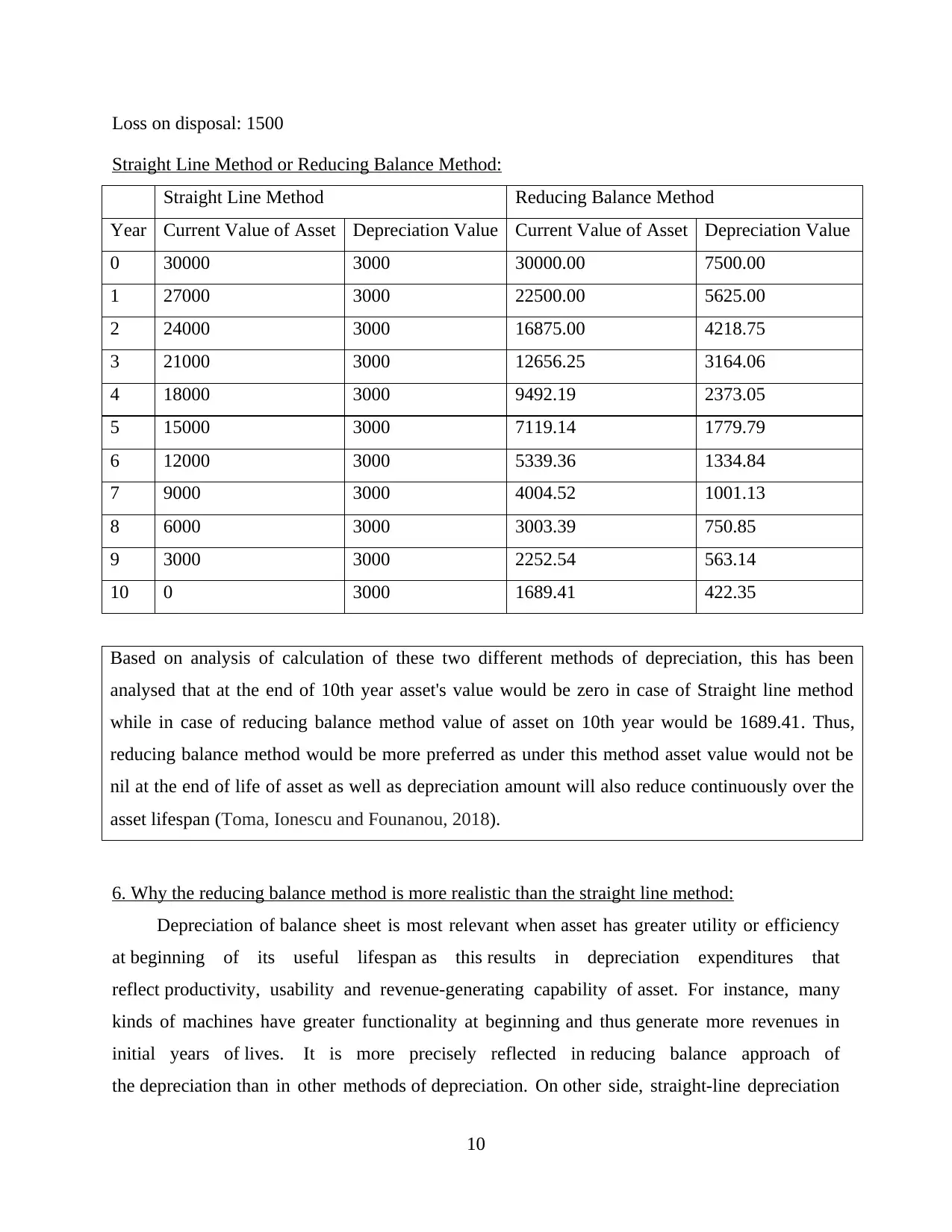
Loss on disposal: 1500
Straight Line Method or Reducing Balance Method:
Straight Line Method Reducing Balance Method
Year Current Value of Asset Depreciation Value Current Value of Asset Depreciation Value
0 30000 3000 30000.00 7500.00
1 27000 3000 22500.00 5625.00
2 24000 3000 16875.00 4218.75
3 21000 3000 12656.25 3164.06
4 18000 3000 9492.19 2373.05
5 15000 3000 7119.14 1779.79
6 12000 3000 5339.36 1334.84
7 9000 3000 4004.52 1001.13
8 6000 3000 3003.39 750.85
9 3000 3000 2252.54 563.14
10 0 3000 1689.41 422.35
Based on analysis of calculation of these two different methods of depreciation, this has been
analysed that at the end of 10th year asset's value would be zero in case of Straight line method
while in case of reducing balance method value of asset on 10th year would be 1689.41. Thus,
reducing balance method would be more preferred as under this method asset value would not be
nil at the end of life of asset as well as depreciation amount will also reduce continuously over the
asset lifespan (Toma, Ionescu and Founanou, 2018).
6. Why the reducing balance method is more realistic than the straight line method:
Depreciation of balance sheet is most relevant when asset has greater utility or efficiency
at beginning of its useful lifespan as this results in depreciation expenditures that
reflect productivity, usability and revenue-generating capability of asset. For instance, many
kinds of machines have greater functionality at beginning and thus generate more revenues in
initial years of lives. It is more precisely reflected in reducing balance approach of
the depreciation than in other methods of depreciation. On other side, straight-line depreciation
10
Straight Line Method or Reducing Balance Method:
Straight Line Method Reducing Balance Method
Year Current Value of Asset Depreciation Value Current Value of Asset Depreciation Value
0 30000 3000 30000.00 7500.00
1 27000 3000 22500.00 5625.00
2 24000 3000 16875.00 4218.75
3 21000 3000 12656.25 3164.06
4 18000 3000 9492.19 2373.05
5 15000 3000 7119.14 1779.79
6 12000 3000 5339.36 1334.84
7 9000 3000 4004.52 1001.13
8 6000 3000 3003.39 750.85
9 3000 3000 2252.54 563.14
10 0 3000 1689.41 422.35
Based on analysis of calculation of these two different methods of depreciation, this has been
analysed that at the end of 10th year asset's value would be zero in case of Straight line method
while in case of reducing balance method value of asset on 10th year would be 1689.41. Thus,
reducing balance method would be more preferred as under this method asset value would not be
nil at the end of life of asset as well as depreciation amount will also reduce continuously over the
asset lifespan (Toma, Ionescu and Founanou, 2018).
6. Why the reducing balance method is more realistic than the straight line method:
Depreciation of balance sheet is most relevant when asset has greater utility or efficiency
at beginning of its useful lifespan as this results in depreciation expenditures that
reflect productivity, usability and revenue-generating capability of asset. For instance, many
kinds of machines have greater functionality at beginning and thus generate more revenues in
initial years of lives. It is more precisely reflected in reducing balance approach of
the depreciation than in other methods of depreciation. On other side, straight-line depreciation
10
Paraphrase This Document
Need a fresh take? Get an instant paraphrase of this document with our AI Paraphraser
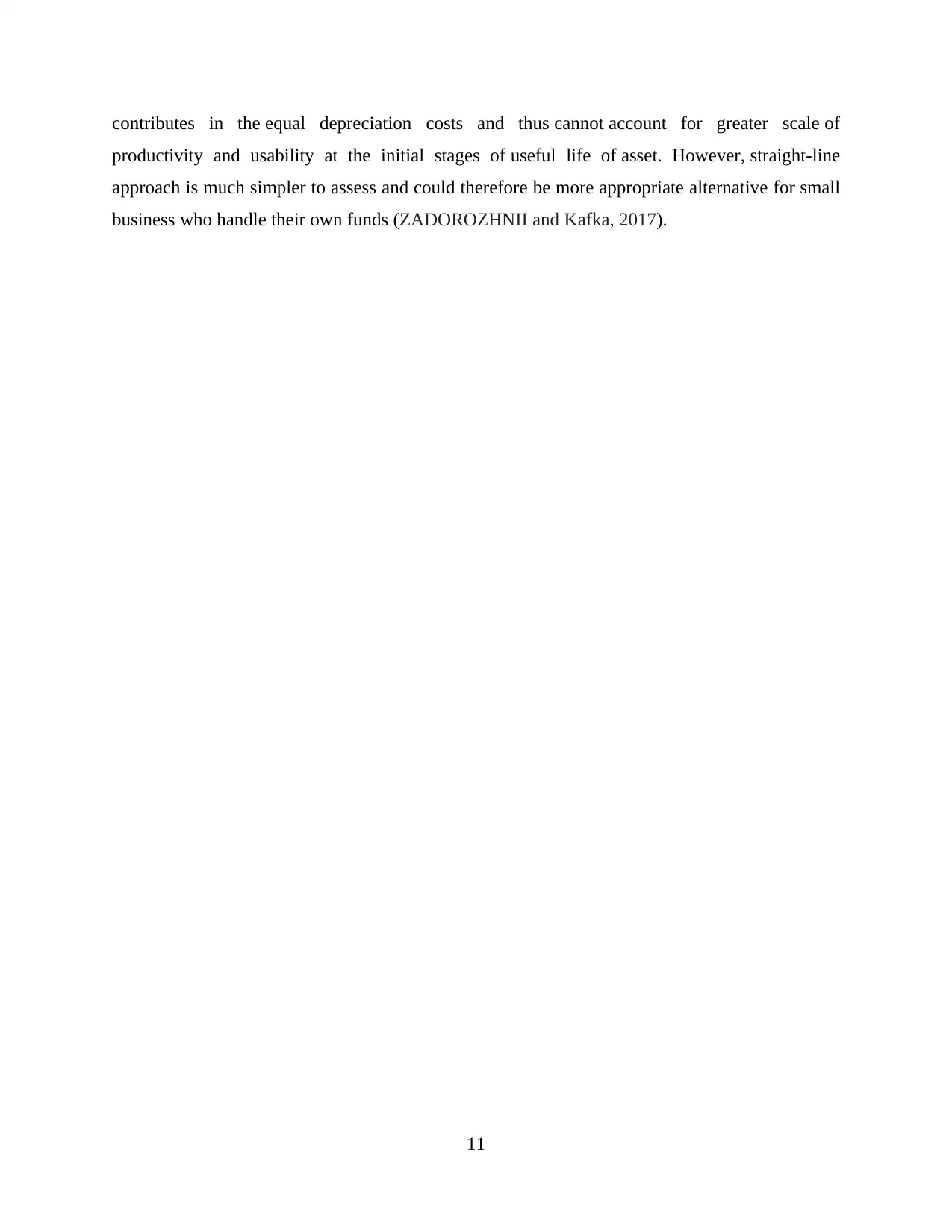
contributes in the equal depreciation costs and thus cannot account for greater scale of
productivity and usability at the initial stages of useful life of asset. However, straight-line
approach is much simpler to assess and could therefore be more appropriate alternative for small
business who handle their own funds (ZADOROZHNII and Kafka, 2017).
11
productivity and usability at the initial stages of useful life of asset. However, straight-line
approach is much simpler to assess and could therefore be more appropriate alternative for small
business who handle their own funds (ZADOROZHNII and Kafka, 2017).
11
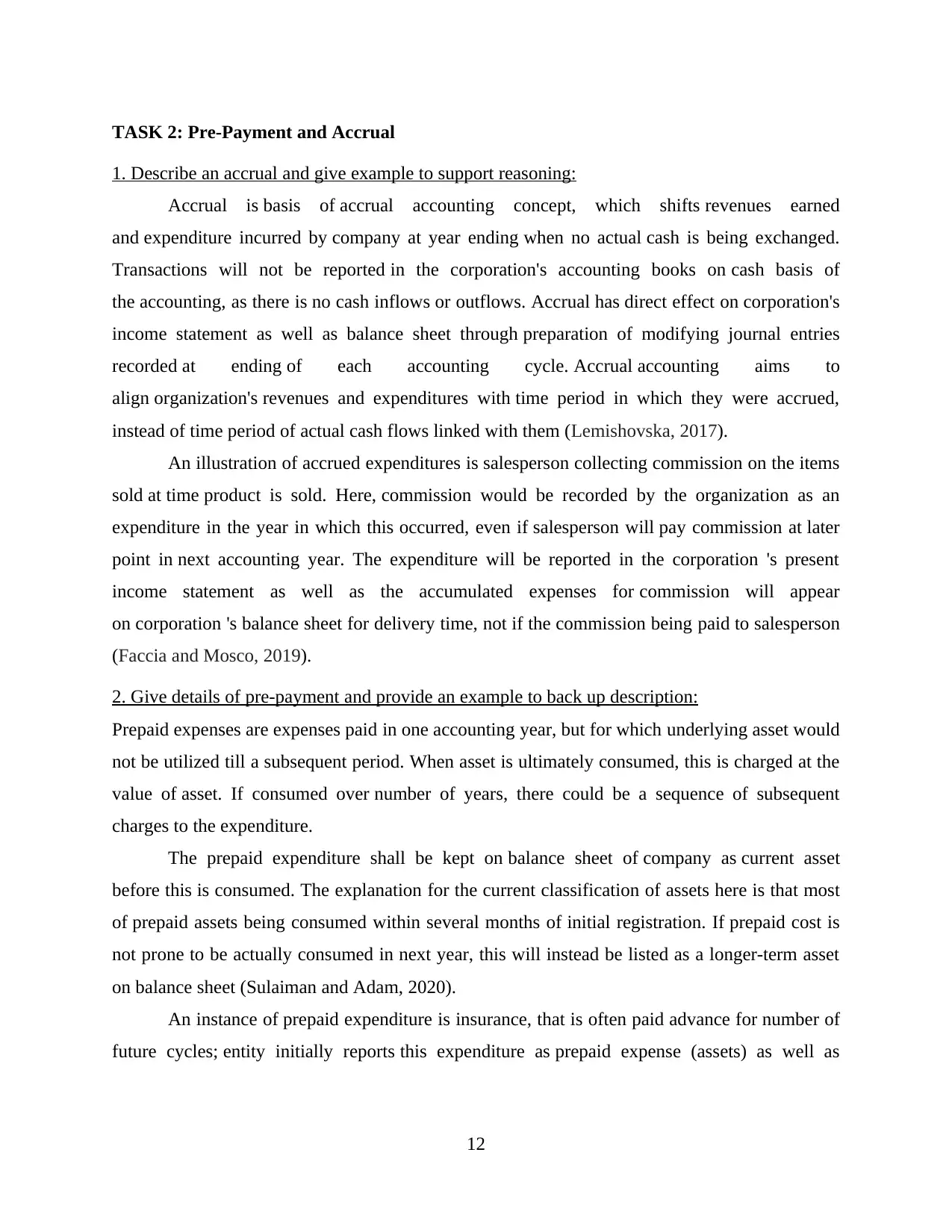
TASK 2: Pre-Payment and Accrual
1. Describe an accrual and give example to support reasoning:
Accrual is basis of accrual accounting concept, which shifts revenues earned
and expenditure incurred by company at year ending when no actual cash is being exchanged.
Transactions will not be reported in the corporation's accounting books on cash basis of
the accounting, as there is no cash inflows or outflows. Accrual has direct effect on corporation's
income statement as well as balance sheet through preparation of modifying journal entries
recorded at ending of each accounting cycle. Accrual accounting aims to
align organization's revenues and expenditures with time period in which they were accrued,
instead of time period of actual cash flows linked with them (Lemishovska, 2017).
An illustration of accrued expenditures is salesperson collecting commission on the items
sold at time product is sold. Here, commission would be recorded by the organization as an
expenditure in the year in which this occurred, even if salesperson will pay commission at later
point in next accounting year. The expenditure will be reported in the corporation 's present
income statement as well as the accumulated expenses for commission will appear
on corporation 's balance sheet for delivery time, not if the commission being paid to salesperson
(Faccia and Mosco, 2019).
2. Give details of pre-payment and provide an example to back up description:
Prepaid expenses are expenses paid in one accounting year, but for which underlying asset would
not be utilized till a subsequent period. When asset is ultimately consumed, this is charged at the
value of asset. If consumed over number of years, there could be a sequence of subsequent
charges to the expenditure.
The prepaid expenditure shall be kept on balance sheet of company as current asset
before this is consumed. The explanation for the current classification of assets here is that most
of prepaid assets being consumed within several months of initial registration. If prepaid cost is
not prone to be actually consumed in next year, this will instead be listed as a longer-term asset
on balance sheet (Sulaiman and Adam, 2020).
An instance of prepaid expenditure is insurance, that is often paid advance for number of
future cycles; entity initially reports this expenditure as prepaid expense (assets) as well as
12
1. Describe an accrual and give example to support reasoning:
Accrual is basis of accrual accounting concept, which shifts revenues earned
and expenditure incurred by company at year ending when no actual cash is being exchanged.
Transactions will not be reported in the corporation's accounting books on cash basis of
the accounting, as there is no cash inflows or outflows. Accrual has direct effect on corporation's
income statement as well as balance sheet through preparation of modifying journal entries
recorded at ending of each accounting cycle. Accrual accounting aims to
align organization's revenues and expenditures with time period in which they were accrued,
instead of time period of actual cash flows linked with them (Lemishovska, 2017).
An illustration of accrued expenditures is salesperson collecting commission on the items
sold at time product is sold. Here, commission would be recorded by the organization as an
expenditure in the year in which this occurred, even if salesperson will pay commission at later
point in next accounting year. The expenditure will be reported in the corporation 's present
income statement as well as the accumulated expenses for commission will appear
on corporation 's balance sheet for delivery time, not if the commission being paid to salesperson
(Faccia and Mosco, 2019).
2. Give details of pre-payment and provide an example to back up description:
Prepaid expenses are expenses paid in one accounting year, but for which underlying asset would
not be utilized till a subsequent period. When asset is ultimately consumed, this is charged at the
value of asset. If consumed over number of years, there could be a sequence of subsequent
charges to the expenditure.
The prepaid expenditure shall be kept on balance sheet of company as current asset
before this is consumed. The explanation for the current classification of assets here is that most
of prepaid assets being consumed within several months of initial registration. If prepaid cost is
not prone to be actually consumed in next year, this will instead be listed as a longer-term asset
on balance sheet (Sulaiman and Adam, 2020).
An instance of prepaid expenditure is insurance, that is often paid advance for number of
future cycles; entity initially reports this expenditure as prepaid expense (assets) as well as
12
⊘ This is a preview!⊘
Do you want full access?
Subscribe today to unlock all pages.

Trusted by 1+ million students worldwide
1 out of 14
Related Documents
Your All-in-One AI-Powered Toolkit for Academic Success.
+13062052269
info@desklib.com
Available 24*7 on WhatsApp / Email
![[object Object]](/_next/static/media/star-bottom.7253800d.svg)
Unlock your academic potential
Copyright © 2020–2025 A2Z Services. All Rights Reserved. Developed and managed by ZUCOL.





